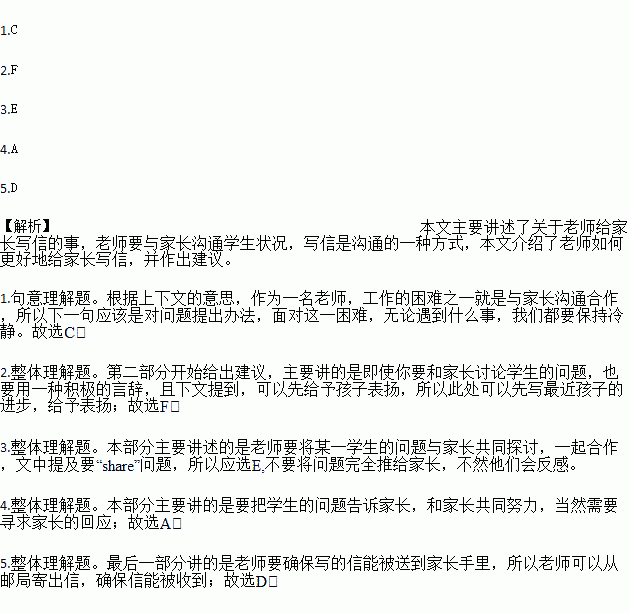题目内容
How to write a Letter to Parents
As a teacher, one of the most difficult parts of your job is working with parents. 1. Writing a letter to parents is one way to do this. If you do it properly, this is an excellent way to communicate when you cannot meet with parents face to face.
·Put positive communication in the letter, even if you are writing to discuss a problem. 2. Even if it is difficult, you must find this positive spin(言辞), because it will make the parents more open to what you have to discuss. The general rule is “start with the good, hit them with the bad, then end on a positive note”.
·Share the problem with the parents. Express your concern and desire to help. 3. Show them through the letter that you want to work with them to find a solution to the problem.
·4. You can ask them to write back, sign a part of the letter or give you a call. If you do not hear from them, you should call them. Be caring, but make sure they got the communication. Remember, your goal is to work together to help their child succeed.
·Consider mailing the letter to the parent, rather than sending it home with the student. Some students will intentionally forget to give the letter to their parents, while others will accidentally or purposely lose the letter. 5.
A. Ask for a response.
B. Respect parents and never quarrel with them.
C. Whenever you meet with problems, you should keep cool.
D. Sending it in the mail makes it more certain that it will be received.
E. Do not place it completely on their shoulders, as they may hate this action.
F. You can do this by pointing out a little progress the child has made recently.
G. With proper communication, however, you can build bridges between the school and home.
COMMERCIAL INVOICE(发货单) | |||||
Date: December 10, 2016 Invoice No: D15454978E Purchase Order No:8928 Bill of loading/ Air Waybill No:2309456703W | |||||
Contact name: Dan Richman Company name: Scan Technology, Ltd. Company address: 2, South Wabash Chicago, IL60637 Telephone number: (1) 319 554 811 E-mail: danrichman@scantech.com | CONSIGN EE(收件人) Contact name: Lee Haojie Company name: First Computers Co. Company address: 35 HeDong Road Beijing, China Telephone number: (86) 134591102 E-mail: haojie@first.com.cn | ||||
Goods Description | Model number | Quantity | Country of Origin | Unit Value | Total Value |
80211 Handheld Scanner | 8021101 | 3 | USA | $120.00 | $360.00 |
80211Base Communicator | 8021183 | 1 | USA | $200.00 | $200.00 |
80211 Cables and Connectors | 8021111 | 3 | USA | $30.50 | $91.50 |
Comments: Mr. Lee, I am able to offer a 8% discount since your total purchase is above $500. We value your business and are looking forward to more opportunities with you. | Invoice Sub Total | $651.50 | |||
Discount | $52.12 | ||||
Insurance | $0.00 | ||||
Invoice Total | $599.38 | ||||
Shipper's signature :Dan Richman | Number of Package | 1 | |||
Total Weight | 5.15kg | ||||
To: Debbie Hu
From: Lee Haojie
Subject: Handheld Scanners
Ms. Hu, I received the parcel from Scan Technology 1 piece. The scanner model they sent is correct, and the quantity is right. However, I’ve discovered the cables and connectors are all wrong. They are not suitable for the model 8021101.
Can you do me a small favor and go through the product information website and see if the cables and connectors are still compatible (兼容的)with the 8021101 scanners? I have no wish to unpack the cables and connectors and try connecting them to the scanners. I believe we will have problem asking for an exchange if the cables and connectors are not compatible. If the website suggests an incompatibility, please contact Dan Richman and request an exchange for the collect model. (Refer to the invoice for his e-mail address.)
I will only use the scanners for our project once we have resolved the exchange issue. We should not proceed unless we get confirmation (证实)on their compatibility. I am looking to resolve this in the shortest possible time as it would be disastrous to wait for this exchange without making progress on the project.
Haojie
1.Which of the following information is NOT included in the invoice?
A. The weight of the individual items.
B. The sender's address.
C. The names of the items sent.
D. The consignee's contact number.
2.What can be indicated from the invoice?
A. Mr. Lee is a regular customer.
B. The company only sends shipments to China.
C. The company provides a discount on purchases of over $ 500.
D. The shipment will arrive at its point of destination on December 10.
3.What is stopping Mr. Lee from opening all the packages?
A. He wants to send them back.
B. He is going to forward them to Ms. Hu.
C. He received some items addressed to someone else.
D. He wants to double-check on the adaptability of some items.
4.Which of the following does Ms. Hu need to know from the invoice if the cables are found to be incompatible with the scanner?
A. Model number: 8021101
B. E-mail address: danrichman@scantech.com
C. Company address: 35 HeDong Road
D. Air Waybill No: 2309456703W


 it outsold every book in the world, except the Bible.
it outsold every book in the world, except the Bible.